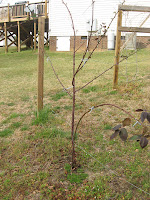At the end of each gardening season it’s a good idea to write notes as to what worked, what didn’t and what changes you would make for the following year. This year we tried several new crops of which some worked and some didn’t.
Two of our new crops were onions and garlic. Both plants start out as a bulb that you plant into the ground but not too deep. Our onions did amazing. I had more onions than I knew what to do with but our garlic bombed.
The thing to remember about onions is to not plant them too deep. The ones that were more on the shallow side did better.
You can tell an onion is ready when it starts to rise up out of the ground. But they also last in the ground where you can only pull up what is needed for dinner. Try to pull up every other bulb allowing those that remain in the ground more growing space. By pulling every other onion the ones on either side expand in size and keep growing. I left my onions in the ground for 2 months only pulling what I needed for that night’s meal. Finally I took a day and harvested the rest.
If you are freezing onions all you need to do is cut them in half and freeze in a freezer safe container.
Our garlic didn’t do so well this year. We planted garlic in a bed where we were going to put our peppers later in the season but sometimes things don’t go as planned. Shortly after we put in the garlic we began to see green leaf lettuce sprouts everywhere. The lettuce ended up covering all 32ft of the bed equaling hundreds of salads and choking out all garlic.
Another new addition to our garden was peanuts. I’ve wanted to grow peanuts for about 2 years but since I don’t know anyone who has done it I have chickened out. Not this year. Turns out peanuts are very easy and bountiful. Peanuts can’t be harvested until October but what I have right now will equal a lot. The peanut plant itself looks like a regular plant with beautiful yellow blooms. The plant will shoot up and out producing pegs (small strands) which attaches to the ground and grows a peanut pod in the soil. Once I harvest them I’ll need to let them dry out. We can’t decide if we will roast them and eat them or make peanut butter. I have a feeling the kids want to eat and not wait for peanut butter.
The last new crop/fruit we took on is a fig tree. Finally I got my fig tree I’ve wanted for year. Our tree started in a nursery so we’ve ended up with 2 rounds of figs but not enough to make fig preserves or fig cookies/newtons. Still if you buy shortbread and eat the figs together you’d think they were fig newtons.
 2 C sugar
2 C sugar









